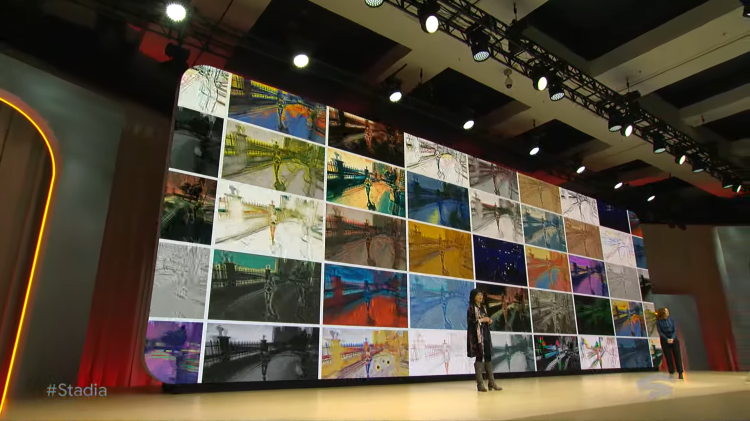testsetset
Last Tuesday, Google announced that Gboard now uses an on-device neural network for speech recognition. This Tuesday, Google announced the Stadia cloud gaming platform. In the span of seven days, Google managed to talk about the benefits of going from the cloud to the edge and about the benefits of going from the edge to the cloud.
This is one of the biggest decisions that companies are toying with today: What goes on the edge and what goes in the cloud? Google’s announcements perfectly illustrate that the answer is simply it depends.
If you can achieve the same results or better, go to the edge. If you can’t, go to the cloud, but make sure you’re reaping all the benefits.
Cloud
There are a few obvious advantages of cloud gaming, at least according to Google’s pitch. Stadia promises that you don’t have to purchase an expensive gaming box; games load faster; and there is “no hacking, no pirating, no cheating.” Again — those are Google’s promises.
June 5th: The AI Audit in NYC
Join us next week in NYC to engage with top executive leaders, delving into strategies for auditing AI models to ensure fairness, optimal performance, and ethical compliance across diverse organizations. Secure your attendance for this exclusive invite-only event.
Google, of course, hasn’t talked about pricing (nor a release date), so we don’t know the total cost here. Presumably, Stadia will require buying a controller plus a monthly subscription that adds up to less than today’s gaming consoles. But there could easily be hidden costs that aren’t as straightforward to account for.
Loading games faster is certainly possible, and Google is even promising low latency. But other companies have promised this before, and Stadia, we can assume, won’t work without an internet connection. And we have no idea how it will work on slow or poor connections.
No hacking, no pirating, and no cheating sounds great. I’m sure gamers will still figure out a way around Google’s systems, but it’s certainly possible that these three issues will all be significantly reduced with a cloud gaming platform.
Cloud gaming has been attempted before, and it failed miserably. Google certainly has the resources to give it a proper go, though, and success would be a huge validation for the cloud.
AI
The cloud conversation is straightforward. Stadia is a cloud gaming service, after all. But what about AI?
The consumer-facing part is of course Google Assistant. Google is positioning YouTube as Stadia’s killer app, but Google Assistant also has a role to play. The Stadia Controller has a Google Assistant button. When you get stuck, instead of scouring YouTube for the right walkthrough explanation, you’ll supposedly be able to push the Google Assistant button for help. How rudimentary or how complex this is will depend on how good the AI is.
The developer-facing part is Style Transfer ML. Style transfer is a machine learning technique that recomposes images in the aesthetic of other images, letting game developers map textures and color palettes from artwork, photos, and still images to game environments automatically. Google needs to woo developers to Stadia, and it’s naturally leaning on its AI chops to do so.
But like everything Google does, Stadia is really about data collection. There’s a reason Google CEO Sundar Pichai kicked off the Stadia announcement with the following:
For many Googlers, their journey with computers started with games. Games have inspired many generations of people to pursue careers in tech. And through that process, they build resourcefulness, creativity, and collaboration — all qualities that are key to solving hard problems. And within Google and Alphabet, games play a big part in developing our own technology. The best example I can think of is how we are making progress on AI.
DeepMind’s AlphaZero uses self-play to learn from scratch and master games like chess, shogi, and Go. It’s an important step towards creating a flexible, general-purpose system that can learn to solve many foundational problems. More recently, AlphaStar became the first AI to defeat a top professional player at Starcraft II using a deep neural network trained directly from raw game data. Increasingly, games are helping AIs learn to tackle real-world challenges.
Even beyond DeepMind, another great example we have is Waymo, where we use simulations and gaming-like environments to test things that aren’t actually possible or safe at scale in the real world. In fact, Waymo’s driven more than 5 billion hours in simulations of edge-case scenarios that vehicles wouldn’t normally encounter. We use it, we learn from it, and actually improve the systems that we’ll be deploying in the real world.
Pulling all that data back into the cloud will help Google — and parent company Alphabet — with a wide array of projects. Alphabet is going to learn a lot from Stadia, and not just about video games.
Games
But the biggest thing Google will have to learn is that in the gaming industry, technology comes second. This is a lesson that Microsoft, Nintendo, and Sony have all learned the hard way over the years.
As long as it works, gamers don’t care if they’re playing on the cloud or on the edge. It doesn’t matter how revolutionary your gaming system is. At the end of the day, gamers care about games. No amount of cloud, AI, teraflops, GPUs, or fancy controllers can help you if you don’t have great games.
Content is king. For that, we’ll have to wait for E3.
ProBeat is a column in which Emil rants about whatever crosses him that week.

